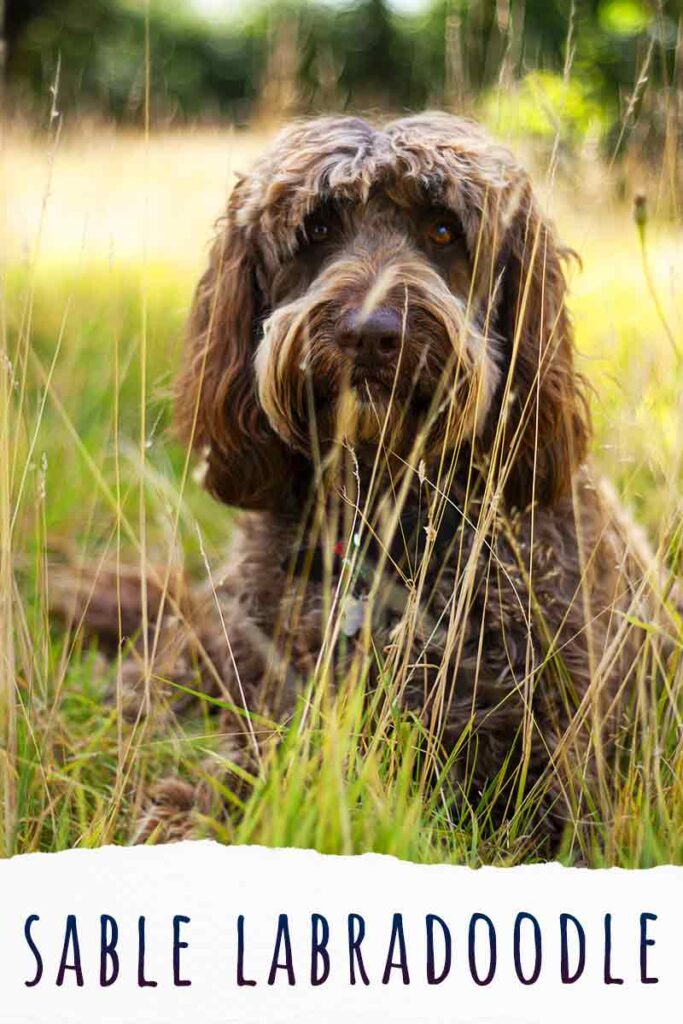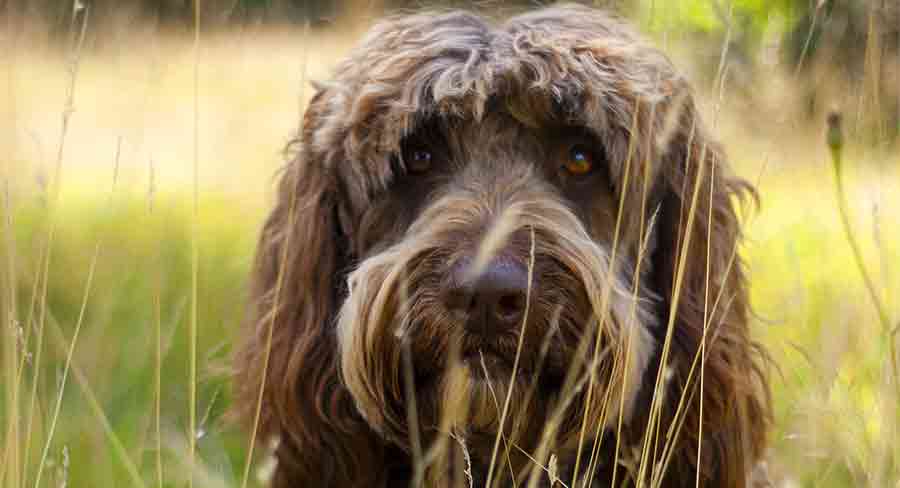The sable Labradoodle is a relatively uncommon coat color for this mixed breed.
“Sable” describes a specific coat pattern. Labradoodles with sable coloring have two colors on each individual hair.
The base of each hair is a solid color, but the tips will be black. This is a pattern that will develop as a dog grows older, puppies aren’t born with sable coloring.
What is a Sable Labradoodle?
When most people think of Labradoodles, they think of solid coat colors. This is, of course, because the mix is part Labrador Retriever, a popular breed with only three colors – yellow, black, and chocolate.
Sable Labradoodles are the same as any other color Labradoodle. The only difference is in their coat pattern.
Doodles with this coloring will have a solid coat color at the base of their hairs. But, at the tips, this color changes to black.
This is what gives the sable pattern its characteristic “wild” look.
Wild canids, like wolves, have a very similar coat pattern, typically called agouti or wild sable.

Where Does the Sable Labradoodle Pattern Come From?
The Labradoodle breed actually has two distinct lines – the American and the Australian varieties.
The Australian Labradoodle dog’s genetic input comes from six different purebred dog breeds:
- Labrador Retriever
- Standard Poodle
- American Cocker Spaniel
- English Cocker Spaniel
- Curly Coated Retriever
- Irish Water Spaniel
But, the American line only contains genetic input from the Labrador Retriever and the Standard Poodle.
Which Ones Have Sable Coloring?
There are no purebred Labrador Retrievers who have sable coats.
But, the Poodle and both Cocker Spaniel varieties carry the gene for sable.
So, both types of Labradoodle can inherit the genes necessary for a sable coat pattern.
In the Australian line, it could come from Poodle or Cocker Spaniel heritage. But, in the American line, it will only be from the Poodle parent breed.
Sable Labradoodle Appearance
As we mentioned earlier, no Labradoodle puppy is born with a sable coat color pattern.
In fact, a Labradoodle puppy that will grow up to have this coat color will typically start out with a chocolate, tan, or black base coat color.
As the young puppy transitions to their adult coat, this base color will lighten. The amount it lightens can vary from one sable Labradoodle to the next.
Some sable Labradoodles might keep a darker base coat color, and others will lighten considerably.
The dark hair tips will show up more clearly when the lighter adult coat starts to grow in.
But, with time, as the coat sheds or gets clipped, the dark tips will become less prominent.
Sable does not express in any rigid standardized pattern. This is exciting, because it means that no two sable Labradoodles will look exactly alike.
Sable Labradoodle Coat Color Genetics
All Labradoodle coat colors develop from two base pigments. All dogs have these two pigments.
- Eumelanin (black)
- Phaeomelanin (yellow)
These two pigments are responsible for producing the full spectrum of Labradoodle coat colors and patterns.
Different shades and markings happen when genes and gene variants (alleles) affect how the two basic pigments show up in your dog’s coat.
This is why eumelanin can encompass midnight black, chocolate brown, or the palest grey. And why phaeomelanin can show up as bright yellow, deep red, or the palest champagne cream.
Color Pattern
Just like genes and alleles can interact to produce different colors, they can create intricate and unique coat patterns on our dogs.
The genes that control the sable coat color are found on the A-Locus.
The A-Locus includes four alleles (gene variants) that control the coat patterns sable and agouti. These can look very similar to one another. In fact, many people mistake them for one another.
Of the four alleles at the A-Locus, the sable allele (Ay) is dominant over the others.
So, a puppy only needs to inherit one copy of the sable gene to have an adult sable coat (solid base with darker tips).
Types of Sable
There are three main sable color patterns. These are:
- Clear sable
- Shaded sable
- Tipped sable
After Ay (sable), the next highest allele is Aw (wild sable). This type is sometimes called wild boar, or simply agouti.
The “w” stands for “wild”. This refers to its similarity to the natural coloration of many wild species, including canids like wolves.
Finding a Sable Labradoodle
Sable isn’t a hugely popular pattern, compared to other Labradoodle shades like apricot, red, and black. So, finding a sable Labradoodle puppy can be a challenge.
On top of this, puppies won’t have the sable coloring until they’re older. And, the Labradoodle has a reputation for coat fading over time.
In some cases, the coat will fade, and those darker tips won’t be that prominent any more. And, remember that some Labradoodles lose those darker tips after they first shed properly, or after their first clip.
If your heart is set on a sable Labradoodle, it’s important to choose a reputable breeder. Don’t prioritise a particular coat color over the general health of your puppy.
Choose a Reputable Breeder
New owners with their hearts set on the sable Labradoodle should choose experienced breeders that work primarily with later-generation Labradoodles.
This means one that breeds two Labradoodles, rather than a Poodle parent and Labrador parent (which would create a first generation Labradoodle).
First generation mixes are less predictable. They could inherit any blend of traits from their two different parent breeds.
And, since we need specific genes from the Poodle for a sable coat color, there’s a higher risk that you won’t end up with a sable Doodle.
When a breeder is breeding established Labradoodle parent dogs, it’s much easier to predict whether a puppy will grow up to have a sable coat color.
The Problem with Breeding for Specific Traits
One last thing to bear in mind is the risk of breeding for specific traits like coat color.
Breeding for certain appearances can lead to a more limited genetic pool. And, it can increase your dog’s risk of certain heritable diseases.
Working with a reputable breeder can reduce this risk.
The best breeder will only breed from healthy lines. They will carry out health tests on potential parent dogs, and will have proof of clean health certificates.
They will also be willing to show you these. If a breeder cannot, or will not, show you evidence of health testing with positive results, you should look elsewhere for a puppy.
Do You Have a Sable Labradoodle?
Sable Labradoodles are quite uncommon, and always memorable. The sable coat might continue to change all throughout life, so each dog is unique.
Are you thinking about adding the sable Labradoodle to your family?
References and Resources
- McKinney, G. ‘What’s the Difference Between Australian Labradoodles and Other Labradoodles?’, Lomond Hills Labradoodles (2021)
- Lewis, L. ‘Labradoodle Coat Colors’, Australian Labradoodle Association (2021)
- Coopshaw, K. ‘Labradoodle Coat Colors’, Worldwide Australian Labradoodle Association (2020)
- Chappell, J. ‘Sable’, Dog Coat Colour Genetics
- Attaway, J. ‘Complete Guide to Labradoodle Colors’, Lakewood Labradoodles (2021)
- Rupert, N. ‘Agouti, Sable, Tan Points and Saddles – The A Series’, Champagne Kennels (2014)
- Animal Genetics UK Staff, ‘A-Locus (Fawn/Sable, Tricolour/Tan Points, Solid Black)’, Animal Genetics UK (2021)
- Rooney, N. & Sargan, D. ‘Welfare Concerns Associated with Pedigree Dog Breeding in the UK’, Animal Welfare (2010)

